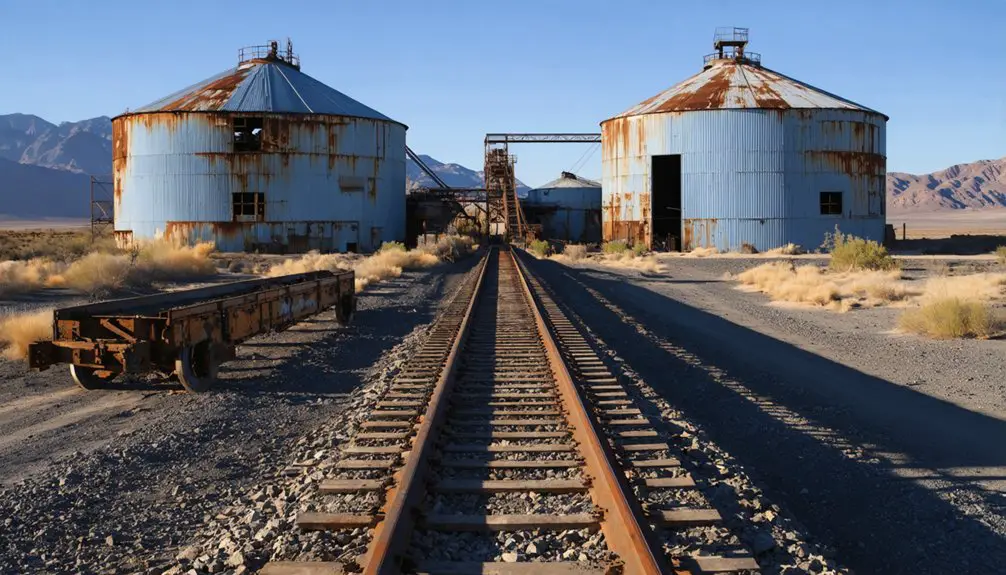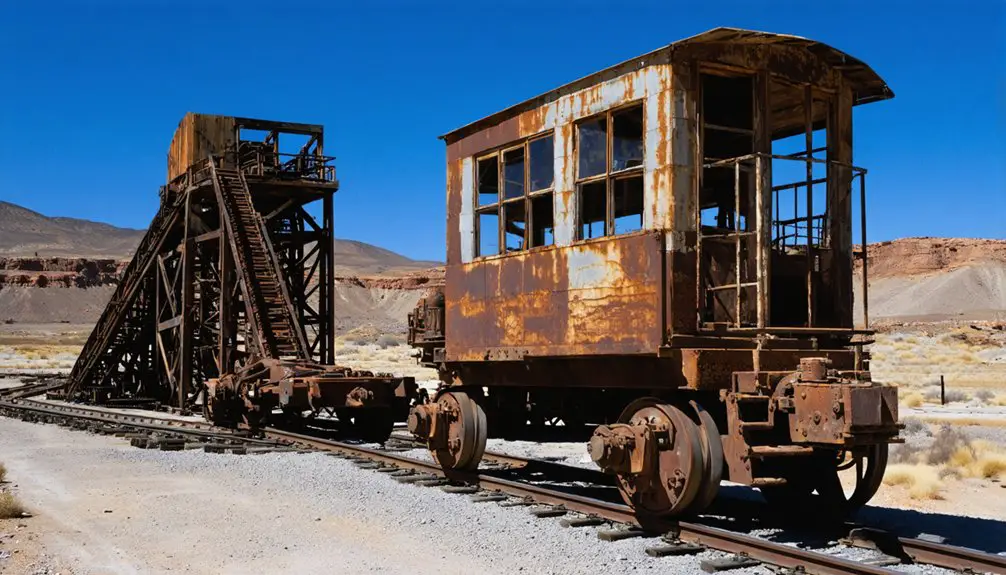You’ll find Caselton, Nevada in the Pioche Hills, where Combined Metals Reduction Company established a company town in 1929. The site flourished through the 1940s and 1950s, processing up to 10,000 tons of silver ore monthly through its state-of-the-art flotation mill. While mining operations ceased in 1978, the town’s remaining structures, including the impressive mill complex, still showcase the innovative mining technology that made Caselton one of America’s most productive silver-lead operations.
Key Takeaways
- Caselton was established in 1929 by Combined Metals Reduction Company as a mining town focused on silver, lead, and zinc extraction.
- The town’s infrastructure included a state-of-the-art flotation mill built in 1941, processing 1,000 tons of ore daily by 1943.
- Mining operations ceased in 1978, leading to the town’s abandonment and subsequent classification as a ghost town.
- Power from Boulder Dam supported the town’s modernization in 1937, bringing electricity to both mining operations and residential areas.
- Environmental concerns persist today, with lead and arsenic contamination from former mining operations requiring ongoing cleanup efforts.
The Birth of a Company Mining Town
The establishment of Caselton in 1929 marked the birth of a strategic company mining town by the Combined Metals Reduction Company (CMR). Named after J.A. Caselton of the National Lead Company, this mining legacy began with the sinking of the Caselton Shaft on the Pioche Hills’ west side, connecting to existing mine workings through an 8,000-foot tunnel. Mining activity in the area dated back to as early as 1917.
You’ll find that Caselton’s foundation represented more than just another mining venture – it formalized a permanent settlement where previous mining efforts had come and gone for decades. The company invested significantly in the area’s development, including building the Caselton Mill in 1941.
As a true company town, CMR developed the site specifically to support underground mining operations at the shaft. The town’s layout centered entirely around mining activities, with residential areas and basic services designed to serve the mining workforce’s needs.
Mining Operations and Mineral Wealth
You’ll find that Caselton’s rich mineral wealth emerged early, with over $5 million in metals extracted by 1872 from the surrounding Pioche Mining District.
The site’s modern operations truly took shape in 1941 when Combined Metals Reduction Company built a state-of-the-art flotation mill capable of processing 500 tons of ore daily, later expanded to 1,000 tons. Combined Metals Reduction operated successfully at the site from 1924 to 1976, establishing a significant mining legacy.
The mine yielded impressive ore grades averaging 5 ounces of silver per ton, along with substantial lead and zinc content.
An extensive underground network, including an 8,000-foot tunnel connecting the Caselton Shaft to other Pioche workings, facilitated efficient ore transport throughout the mining complex.
Rich Silver Production History
Mining activity in Caselton began around 1917, but significant developments emerged in 1929 when Combined Metals Reduction Company (CMR) sank the Caselton Shaft.
You’ll find that silver mining drove the area’s early prosperity, with the Pioche Mining District producing over $5 million in metals by the early 1870s. The district’s wealth expanded through an 8,000-foot tunnel connecting Caselton Shaft to earlier workings above Pioche.
During the 1940s and 1950s, silver mining sparked substantial economic growth in the region. The operation reached impressive production rates of 10,000 tons monthly, processing complex polymetallic ores through the Caselton mill’s advanced flotation system.
While silver dominated production, you’ll discover the mines also yielded significant amounts of lead, zinc, and smaller quantities of gold and copper.
Modern Mill Technology 1941
During 1941, Combined Metals Reduction Company revolutionized Caselton’s mining operations by constructing a state-of-the-art mill featuring advanced flotation technology.
You’ll find this modern milling facility initially processed 500 tons of ore per day, but rapid technological advancements doubled its capacity to 1,000 tons by 1943.
The mill’s construction coincided with significant infrastructure improvements, including a new power transmission line from Boulder Dam and upgraded Union Pacific rail lines.
These developments transformed Caselton’s mining capabilities, allowing you to see how the flotation process made previously unprofitable low-grade ores economically viable. The innovative selective flotation process, developed in 1924, enabled efficient separation of complex sulfide ores.
The mill sustained local mining activity through the 1940s and early 1950s until ore depletion led to its closure in 1957, though it briefly reopened for intermittent processing until 1978.
Underground Tunnel Network System
The underground maze beneath Caselton began in 1929 when Combined Metals Reduction Company sank their No. 2 shaft on the west side of Pioche Hills.
Their tunnel engineering connected this shaft to earlier workings through an 8,000-foot tunnel at the 1,200-foot level, giving you access to rich deposits of silver, lead, and zinc beneath the surface.
You’ll find this network was a marvel of mining safety and efficiency for its time. The tunnels supported heavy machinery while providing essential ventilation and drainage. The C.M.R. mill processed approximately 4,000 tons of ore monthly by 1926.
By 1872, miners had already extracted over $5 million in metals, and the system’s strategic design allowed them to tap into even deeper ore bodies.
Operations thrived until 1957, when ore depletion led to the mine’s closure, though some processing continued into the late 1970s.
Life in a Controlled Community
Life in Caselton revolved around a tightly controlled community structure, where residents adapted to both corporate oversight and rural isolation.
You’d find community dynamics shaped by the Combined Metals Reduction Company‘s dominant presence, which managed both mining operations and land access. Your daily existence would’ve centered on demanding physical labor challenges, whether you worked in the mines or maintained one of the area’s ranches.
Without modern conveniences until 1937’s electrification, you’d spend your days washing clothes on washboards, hauling wood for heat, and performing endless manual chores.
While ranchers enjoyed some freedom in grazing their cattle on shared lands, the mining company’s influence permeated every aspect of life. Even leisure activities remained limited to simple outdoor pursuits like horseback riding, reflecting the constraints of this company-dominated town.
The Modern Mill Complex

Modern industrial innovation arrived in Caselton with construction of a state-of-the-art flotation mill in 1940, transforming the mining town’s capabilities.
You’ll find this mill complex was built following the arrival of power from Boulder Dam and upgraded rail connections, enabling efficient ore processing at 500 tons daily capacity.
Despite operational challenges, the mill’s technology proved so successful that capacity doubled to 1,000 tons by 1943.
You can trace the mill’s productive years from 1941 through 1957, when ore depletion led to its first pause.
Though it reopened in 1964 for the Pan American Mine’s output, all operations ceased by the late 1970s.
Today, while the mill buildings stand intact, they’re privately owned and silent, marking the end of Caselton’s industrial era.
Underground Networks and Infrastructure
You’ll find the heart of Caselton’s underground operations at the No. 2 shaft, sunk in 1929, which connected to an extensive network of tunnels reaching 8,000 feet toward Pioche.
The mine’s infrastructure supported both ore extraction and water processing operations, with electric power from Boulder Dam energizing the underground works after 1937.
The underground system remained active through various mining companies until the 1970s, facilitating ore transport and mill operations until sulfide reserves were finally depleted.
Mining Shaft Connections
Deep beneath Caselton’s surface, an intricate network of mining shafts and tunnels stretched across the Pioche Hills, anchored by the landmark Caselton Shaft constructed in 1929.
You’ll find shaft connections extending 1,200 feet vertically, linking to an extensive 8,000-foot tunnel system that integrated both new and existing underground operations.
The Combined Metals Reduction Company enhanced these tunnel integrations throughout the 1930s and 1940s, connecting to historic workings like the Raymond & Ely No. 1 shaft and St Patrick Mine.
This underground network served multiple purposes, extracting silver, lead, and zinc through a complex system of drifts and levels.
Modern infrastructure, including electric hoisting equipment and ventilation systems, supported the miners working deep within these interconnected passages, maximizing efficiency and safety.
Environmental concerns arose when waste rock deposits containing elevated metal concentrations accumulated near these extensive mining operations.
Ore Transport Systems
While extracting precious metals from Caselton’s rich deposits posed significant challenges, the mine’s sophisticated ore transport network revolutionized material handling efficiency throughout the site.
You’ll find extensive underground conveyor belts stretching thousands of feet between the Caselton Shaft and flotation mill, dramatically improving conveyor efficiency during peak operations of the 1940s-50s.
The tramway design incorporated gravity-fed ore chutes and electric locomotives running through 8,000 feet of reinforced tunnels.
This integrated system connected to the Union Pacific Railroad‘s Prince line, completed in 1940, which transported ore to regional smelters.
Underground stockpiles and loading yards near the mill guaranteed consistent production flow, while ventilation systems supported the workers and equipment operating this complex transport network, particularly during the war years when production reached 1,000 tons daily.
Mill Processing Networks
Through a sophisticated network of underground infrastructure, Caselton’s mill processing system connected multiple mining operations via an 8,000-foot tunnel system completed in 1941.
You’ll find the Caselton Mill’s initial 500-ton capacity was doubled to 1,000 tons by 1943, showcasing the operation’s rapid expansion.
The mill operations relied on the No. 2 Caselton Shaft as the primary vertical access point, while crosscut tunnels and drifts facilitated ore extraction and ventilation.
Processing techniques were powered by electricity from Boulder Dam’s transmission line, installed in 1937.
The Combined Metals Reduction Company maintained this complex network from the 1920s through the late 1970s, adapting the infrastructure with steel reinforcements and timbering to support increased production demands throughout the mid-20th century.
Connection to Historic Pioche
Although Caselton emerged much later than its neighbor Pioche, these two mining communities became inextricably linked within Lincoln County’s rich mining landscape.
Caselton and Pioche, though established in different eras, grew into inseparable mining towns in Lincoln County’s mineralogical tapestry.
The Caselton connections to Pioche ran deep, with the Combined Metals Reduction Company‘s 1923 acquisition creating a unified mining operation across both towns. You’ll find historic links everywhere – from the 8,000-foot tunnel connecting their underground workings to the shared railroad infrastructure that served them both. The Pioche & Bullionville Railroad helped establish early transportation routes in 1873. The introduction of flotation processes in 1924 revolutionized the extraction of zinc-lead sulfide ores in both areas.
When Caselton’s mill opened in 1941, it became a crucial processing hub for Pioche district ores.
The modernization brought by CMR, including electric power from Hoover Dam and expanded rail services, transformed both communities into an integrated mining complex.
Even after Pioche’s mining declined in 1958, Caselton’s facilities continued processing ore from the surrounding district.
The Final Years and Closure

The gradual decline of Caselton’s mining operations began in 1957 when ore depletion forced the original mill to halt production.
Despite brief signs of community resilience, including resumed milling in 1964 to process ore from the Pan American Mine, the economic shifts proved insurmountable.
Similar to the fate of Lucky Star Mine, Caselton’s mining operations yielded minimal production in its final years of activity.
The Combined Metals Reduction Company‘s bankruptcy in the early 1970s marked a turning point, leading to Kerr-McGee Corporation‘s acquisition of mining claims in 1976.
Commercial milling operations ceased definitively by 1978, and the removal of the railroad line in 1984 severed crucial transportation links.
By 1993, unpatented mining claims had lapsed to the Bureau of Land Management, while Caselton Heights maintained only a small residential presence.
The once-bustling mining town transformed into a restricted-access ghost town, marking the end of its industrial era.
Environmental Impact and Cleanup
Since Caselton’s mining operations ceased in 1978, lead and arsenic contamination has posed significant environmental challenges at the site.
You’ll find the primary concerns center around waste rock and tailings, which continue to impact soil and water quality through contaminant migration during storms.
The Multistate Environmental Response Trust now manages ongoing cleanup efforts, with key focuses including:
- Isolating contaminated materials to protect humans and wildlife
- Implementing soil stabilization and stormwater control measures
- Conducting regular monitoring along Caselton Wash
Multiple remedial strategies are being deployed across different operational units, with OU4 (mill site) and OU5 (wash tailings) receiving priority attention.
While funding limitations require a phased approach, the Nevada Division of Environmental Protection oversees these cleanup activities to guarantee they meet risk-based standards for future recreational and industrial use.
Preserved Structures and Present Status

Walking through Caselton today, you’ll discover remnants of its mining heyday, including the prominent 800-foot shaft and mill facilities established in 1929 by the National Lead Company.
The mill, which operated until 1957 and processed ore sporadically until 1978, stands as a reflection of Nevada’s industrial past.
You’ll find about 30 residents still living near the historic townsite, where deteriorating company buildings and community artifacts paint a picture of the once-bustling mining camp.
While preservation efforts are limited primarily to environmental cleanup by the Nevada Division of Environmental Protection, the community building and various industrial structures remain visible.
The site’s divided operable units help manage contamination from mill tailings, though many original structures continue to decay under desert conditions.
Frequently Asked Questions
Were There Any Major Mining Accidents or Disasters in Caselton’s History?
You won’t find any documented major disasters in mining safety records. While Nevada had numerous accidents elsewhere, accident reports and historical archives don’t show catastrophic events at Caselton’s operations.
What Happened to the Residents After the Town Was Abandoned?
Persistently pursuing prospects, you’ll find residents relocated to places like Pioche and Caselton Heights. Some sought survival through jobs at Pan American Mine, while others faced challenging relocation stories in Nevada’s larger cities.
Did Any Famous People or Notable Historical Figures Visit Caselton?
You won’t find any famous visitors in Caselton’s records. While the town held historical significance for its mining operations, there’s no evidence of celebrities or notable historical figures ever visiting there.
How Much Would a Miner Typically Earn Working in Caselton?
You’d have earned about $3-7 daily during peak operations (1929-1957), with wage fluctuations based on your role and skill level, shaping miner lifestyles through both boom and bust periods.
Were There Any Schools or Churches Established in the Town?
You won’t find education facilities or places of religious significance in this town – historical records don’t show any schools or churches being established during its operational years as a mining community.
References
- https://coloradosghosttowns.com/Caselton NV.html
- https://www.youtube.com/watch?v=auSc3fTx6hA
- https://www.nvexpeditions.com/lincoln/caselton.php
- https://nvtami.com/2025/06/25/lincoln-county-ghost-town-trip/
- https://ndep.nv.gov/land/abandoned-mine-lands/caselton-mine
- https://en.wikipedia.org/wiki/Caselton
- http://www.nv-landmarks.com/towns-c/caselton.htm
- https://caselton.greenfieldenvironmental.com/overview
- https://westernmininghistory.com/mine-detail/10037330/
- https://ronhess.info/docs/report7_history.pdf



